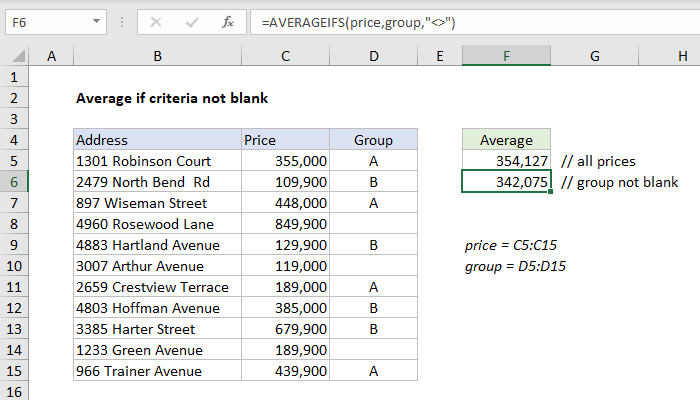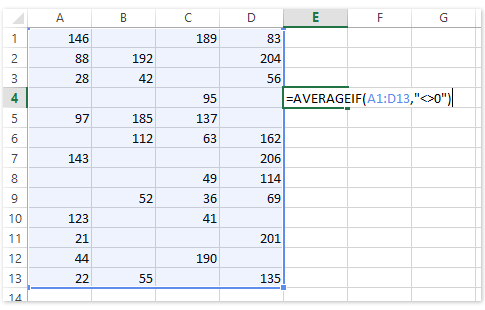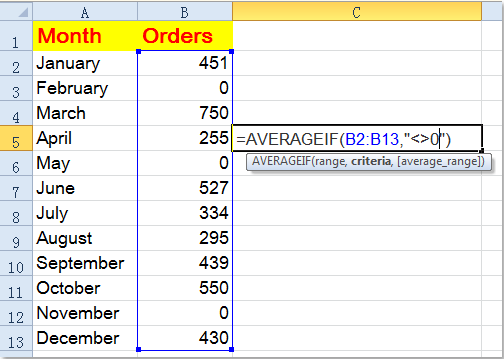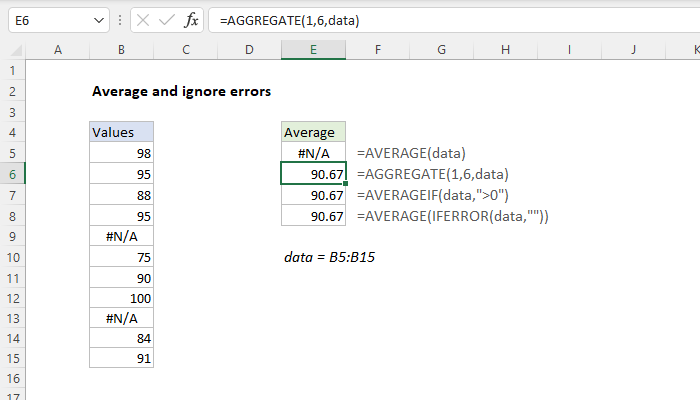AVERAGEIFS Average_range range. For example you want to average the Range A1D13 with ignoringexcluding blank cells and zeros you can apply the formula AVERAGEIFA1D130 as below screenshot shown.

How To Average For Cells With Values Only Exclude 0 Or Blank Cells In Excel
For example you want to add 1 to all cells in range D2D7 and if you directly use the formula D21 and the blank cells also will be added 1.

Excel formula average excluding blank cells. If a cell has a formula that produces a null result the cell appears to be blank However if you apply ISTEXT or ISBLANK to that cell a TRUE and FALSE result is respectfully returned. This formula forces the blank values to be converted to 0 before taking the average and hence we get the desired result 234343232443994 and divided by 64 values2 blanks which is 66566. When you have all of the cells selected close your parenthesis add.
Select a blank cell for example E2 enter the formula AVERAGEIFA1C50. Verify that average is calculated properly. Enter the formula SUMPRODUCTAVERAGE0A2A7 in cell C4.
Actually excel can calculate the average ignore the blank cells. You can leave out any cells you want. The basic AVERAGE function automatically excludes genuinely blank cells.
My zero length strings were perfectly correlated with a. For example the following formula calculates an average of cells C2C8 if a cell in column B in the same row is absolutely empty. Average if blank.
Average values if cells are not blank using VBA. And you can use the IF function the ISNUMBER function the AND or OR function to achieve the result. AVERAGEIFS price group.
In this way you can use this formula to ignore the blank cells while the calculation is performed. The picture above seems to have blank. It disregards blanks excel 2003 but takes into account zeros.
For example with this data. The AVERAGE AVERAGEIF and AVERAGEIFS function all automatically ignore blank cells and cells that contain text values so there is no need to provide criteria to filter out empty cells. We find that once the formula has been copied to the whole column only cells C2 and C5 show the result while C3 C4 and C6 are blank as any of the cells in these rows are blank.
In the cell where you want the average to be type AVERAGE Then hold down control and click on all of the cells you wish to average. The formula uses the Excel AVERAGEIF function to average the numbers that do not have a blank cell in the corresponding cells in range B5B11. Excel PivotTables count those as zeroes which can artificially lower the Average.
For example you need to calculate the average of three dates quantity of Apple excluding zero cells in the table you can apply the following formula. I solved this Average issue with a PivotTable filter. Press Enter to get the average.
AVERAGEIFA1A110 This formula eliminates zero values as a result of the criteria expression and Blank cells as default functionality of AVERAGEIF function so it only counts. IF A4MIN C4C4C46711 B4B4B46711 A4A46711First EventAll Im using the same one for MAX and it works just fine. To include blank cells that contain absolutely nothing no formula no zero length string enter in the criteria argument.
Average for cells with values only exclude blank cells with Kutools for Excel. But when changing to MIN it fails and I suppose its because of value 0 andor blank cells. Cell A11 Cell A2blank Cell A32 The formula.
Ive learned that Excel treats blank cells differently. In the example shown the formula in F6 is. By using the AVERAGEIF function with criteria expression Not Equal to Zero 0 you will average cells ignoring zero and Blank values.
This is the most convenient way to calculate the average for selected range without zero and blank cells. Here we are given the data and we needed to find the AVERAGE of the numbers ignoring blank cells in Excel Generic formula. But LEN applied to the cell.
Select a blank cell enter formula AVERAGE IF MOD COLUMN C2G2-COLUMN C220IF C2G2C2G2 into the Formula Bar and then press the Ctrl Shift Enter keys simultaneously. AVERAGEIFB3B80B3B8 The formula above is an array AVERAGE ignore blanks The AVERAGE function is designed to ignore blank cells. You can use the average formula.
The AVERAGE function is designed to ignore blank cells but there are instances where it fails. To calculate an average excluding blank values in a criteria range you can use the AVERAGEIFS function and a simple logical expression. If you have a formula to calculate a range of cells and you want to ignore the blank cells.
The formula in this case would be. The array formula in cell D3 calculates an average and ignores 0 zeros. Those blank cells are probably formulas returning zero length strings ie.
Now we will see here how to calculate the average of values taking blanks into consideration as shown in cell C4.

Excel Formula Average Numbers Ignore Zero Exceljet

How To Calculate Average Cells From Different Sheets In Excel

Average Numbers If Not Blank In Excel

How To Average For Cells With Values Only Exclude 0 Or Blank Cells In Excel

How To Average A Range Of Data Ignoring Zero In Excel

How To Average For Cells With Values Only Exclude 0 Or Blank Cells In Excel

Excel Formula Average If Criteria Not Blank Exceljet

Excel Formula Average And Ignore Errors Exceljet

How To Calculate Average Ignore Blank And Zero Cells In Excel Free Excel Tutorial
Tidak ada komentar:
Posting Komentar